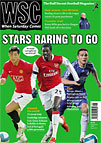 Financial restraints are making the Irish leagues consider dramatic changes, writes Geoff Wallis
Financial restraints are making the Irish leagues consider dramatic changes, writes Geoff Wallis
As AGMs go it was as cosy as they come when the Football Association of Ireland met in Castlebar, County Mayo, on July 26. Chief executive John Delaney reported a healthy increase in turnover, that financial plans were well in place to secure the FAI’s role when the rebuilt Lansdowne Road reopens in 2010, and that their assumption of control over the Eircom League had seen an aggregate attendance rise of 100,000 over the last year. That figure represents slightly more per game than the mere 320 who attended the 4‑0 victory by Waterford (Delaney’s local side) over Longford the previous night.
Yet all is clearly far from well in the state of football in the Republic. Eircom is withdrawing its sponsorship after nine years, leaving only the broadcaster Setanta with its televised cross-border Sports Cup as a major backer. Several clubs are experiencing severe financial difficulties, partly caused by the FAI’s stipulation that only 65 per cent of turnover can cover players’ wages, reduced from 95 per cent in previous years – fine for those few clubs with average home attendances over 2,000 but disastrous for the rest, most of which owe huge sums in unpaid tax. Coming on the back of Shelbourne’s virtual collapse then demotion to the First Division and Kilkenny City’s demise in 2007, member-owned Sligo Rovers have launched a public appeal to ensure that the side see out the current season. Galway United’s financial stock has sunk so low that their distinctly overweight player-manager Jeff Kenna has been forced to turn out at full-back in recent games.
One key item was noticeably absent from the FAI’s AGM agenda – proposals for an all-Ireland league put forward by a sports-marketing company Platinum One. Leaked in July, the plan is to start the league in August 2009 – returning the Republic’s senior football to a winter season in the process. There would be ten clubs, seven from the Republic (Bohemians, Cork City, Drogheda United, Galway United, St Patrick’s Athletic, Shamrock Rovers and Limerick 37 – a 2007 franchised replacement of the old Limerick City) plus three from the North (Derry City, who currently play in the Eircom League, Linfield and Glentoran). This league would operate with its members intact for two years before promotion and relegation would begin to operate from the residual clubs in leagues north and south of the border.
Platinum One’s proposals are heavy on ideas but light on substance. The goal, as illuminated by the author of the report, Fintan Drury (former chairman of the broadcaster RTÉ and current chairman of the bookmakers Paddy Power), is to raise the standard of Irish football, both at league and national levels, and draw increased finance through broadcasting franchises. However, while nobody would argue with the first of those proposals, it’s unclear how a self-maintaining elite could possibly achieve this goal.
Furthermore, the FA of Northern Ireland (known as the Irish FA) – who launch their own new Premier League in August – have rejected the proposals and, while the FAI have not reacted so strongly, all of its current Eircom League member clubs are bound by participatory agreements in force until 2011.
Fans have been resolutely opposed to the plans. They appreciate that major clubs effectively provide income for less-favoured ones in their division. However, few see the benefits of proposals that ignore a proper all-Ireland league pyramid and effectively enrich relatively well off city clubs at the expense of their small-town and, in some cases, rural colleagues. Even fewer can see how a game between Glentoran and Limerick 37 will increase interest, or attract travelling fans.
This “select ten” are hardly in good shape. One of the bigger clubs may get an occasional European pay day, but the condition of the majority of grounds is dire in comparison to the Conference. Nor does anyone at Platinum One seem to have worked out the repercussions of its plan for clubs’ qualification for European competitions or the UEFA coefficient effect on this new league’s status.
Irish football continues to be handicapped by a fundamental problem. Overall, it is only the third most popular sport, behind Gaelic football and hurling, and that will remain the case until its qualities are made apparent to the public. But without regular broadcasting and its resulting revenue, the best players are enticed by better wages across the water. The game in Ireland remains at a low ebb.
From WSC 259 September 2008